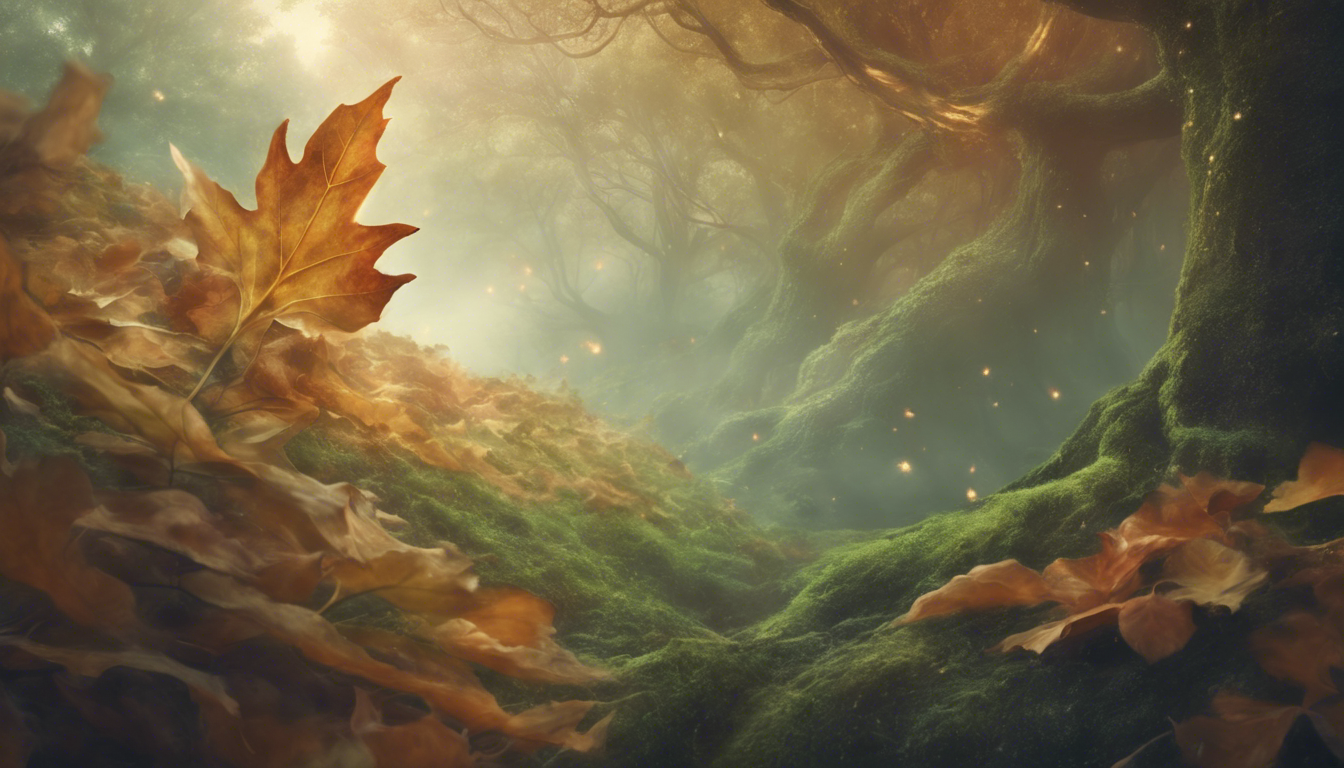Title: Unveiling the Meaning Behind the Leaf Symbol
In this article, we delve into the fascinating symbolism of the humble leaf, exploring its deeper meanings and significance in various cultures and contexts. Join us on this insightful journey as we unravel the mysteries behind this simple yet powerful natural symbol.
symbolism in nature

Nature, with its beauty and complexity, has always been a rich source of symbolic meanings that have resonated with humanity throughout history. Exploring symbolism in nature allows us to delve deeper into the profound connections between the natural world and our inner selves. Let’s embark on a journey to uncover the symbolic treasures that nature holds.
the elements: earth, water, air, fire
Earth symbolizes grounding and stability, representing the physical realm and our foundation. It is associated with growth, fertility, and abundance. Water embodies emotions, intuition, and purification. It flows and adapts, reflecting the ever-changing nature of our feelings. Air signifies intellect, thought, and communication. It is linked to freedom, clarity, and new ideas. Fire represents transformation, passion, and creative energy. It symbolizes both destruction and renewal, reminding us of the cycle of life.
plants and animals
Plants are often seen as symbols of growth, healing, and renewal. Each plant species carries its unique symbolism; for example, roses symbolize love and beauty, while oak trees represent strength and endurance. Animals in nature also hold symbolic meanings. The wise owl symbolizes wisdom, the majestic lion represents courage, and the graceful deer embodies gentleness and intuition.
seasons and cycles
The changing seasons symbolize the cycles of life, with spring representing new beginnings, summer symbolizing growth and vitality, autumn embodying harvest and reflection, and winter signifying rest and introspection. These seasonal transitions remind us of the constant changes and rhythms of nature that mirror our own inner transformations.
spiritual connections
Many spiritual traditions around the world have drawn inspiration from nature’s symbolism. Native American cultures view animals and plants as spiritual guides, while Eastern philosophies derive profound teachings from the elements and seasons. Exploring symbolism in nature can deepen our spiritual connection to the universe and enhance our self-awareness.
Exploring symbolism in nature opens up a world of meaning and significance that can enrich our lives and expand our perspectives. By understanding the symbolic language of nature, we can tap into its wisdom and find deeper meaning in our experiences. Let’s continue to explore and appreciate the profound symbolism that nature offers, connecting us to the essence of existence.
cultural significance

symbols hold a profound cultural significance across the world, representing values, beliefs, and identities that are deeply rooted in societies. these symbols, whether tangible or abstract, play a crucial role in shaping cultural norms and traditions.
The Power of Symbols
symbols serve as powerful communicative tools, transcending language barriers to convey meanings that resonate on a universal level. they act as visual representations of complex ideas, emotions, and concepts, fostering a sense of unity and connection among individuals within a community.
Diverse Cultural Symbols
– religious symbols such as crosses, crescents, or mandalas hold sacred meanings within different faith traditions, signifying spiritual beliefs and practices.
– national symbols like flags, anthems, or emblems embody a country’s heritage, values, and aspirations, fostering patriotism and unity among its citizens.
– cultural symbols such as totems, masks, or traditional costumes reflect a community’s history, customs, and social structures, preserving its unique identity for future generations.
Symbolism in Art and Literature
the use of symbols in art and literature dates back centuries, with artists and writers incorporating symbolic motifs to convey deeper layers of meaning and evoke emotional responses from audiences. from ancient cave paintings to modern poetry, symbolism adds richness and complexity to creative expressions.
Preserving Symbolic Traditions
in a rapidly changing world, it is essential to preserve and revitalize symbolic traditions to ensure their continued relevance and significance in contemporary society. by understanding the cultural context and historical importance of symbols, we can appreciate their enduring impact on our collective heritage.
symbols are not merely decorative elements but essential components of cultural identity and heritage. by recognizing the profound cultural significance of symbols, we can enhance our understanding of diverse traditions and foster cross-cultural appreciation and respect.
religious associations

In the realm of spirituality, symbols hold a profound significance that transcends words and logic. Religious associations are rich with symbolism, each image or object carrying layers of meaning that provide insight into the beliefs and practices of a particular faith tradition. By delving into the symbolism of religious associations, we can gain a deeper understanding of the spiritual essence they represent.
the power of sacred symbols
Sacred symbols play a vital role in religious practices, serving as a bridge between the material and the divine. Whether it’s the Om symbol in Hinduism, the cross in Christianity, or the Star of David in Judaism, these symbols hold immense power to evoke a sense of connection with the divine. They are often used in rituals, ceremonies, and meditation practices to deepen spiritual awareness and contemplation.
symbolism in architecture
Architecture in religious buildings is not merely a physical structure but a reflection of spiritual symbolism. From the intricate designs of stained glass windows to the layout of sacred spaces, every aspect of religious architecture is imbued with symbolic meaning. The use of certain shapes, colors, and patterns can convey profound spiritual truths and guide worshippers in their meditative journey.
symbolic rituals and practices
Rituals and practices within religious traditions are often laden with symbolism, carrying a deeper significance beyond their outward appearance. Whether it’s the lighting of candles, the offering of incense, or the recitation of prayers, each action holds symbolic value that connects the practitioner to the divine realm. Understanding the symbolism behind these rituals can enrich one’s spiritual experience and foster a deeper sense of connection with the divine.
symbolism in religious art
Religious art serves as a visual expression of spiritual truths, using symbols and imagery to convey complex theological concepts. From iconic representations of deities to intricate mandalas, religious art is filled with symbolism that speaks to the heart and soul of believers. By contemplating the symbolism within religious art, one can explore the depths of spiritual wisdom and beauty that transcend cultural boundaries.
In conclusion, exploring the symbolism of religious associations is a gateway to understanding the profound mysteries of spirituality. From sacred symbols to architectural marvels, from ritual practices to artistic expressions, each facet of religious symbolism offers a glimpse into the divine presence that permeates all aspects of life. By immersing ourselves in the rich tapestry of religious symbolism, we embark on a transformative journey of the soul.
artistic representation
symbolism has long been a powerful tool in artistic expression, allowing artists to convey deeper meanings and evoke emotions beyond the surface. through various artistic mediums, symbols have been used to communicate themes, ideas, and messages that resonate with viewers on a profound level.
visual representation
in visual arts, symbols are often depicted through iconography, employing specific images or objects with symbolic significance. for example, the use of a dove to symbolize peace or a heart to represent love. these visual representations serve as a universal language, transcending cultural barriers and connecting people through shared interpretations.
metaphorical meaning
beyond the literal interpretation, symbols in art often hold metaphorical meanings that invite viewers to delve deeper into the artwork’s narrative. a symbolic representation of a storm, for instance, could signify inner turmoil or upheaval, adding layers of complexity to the piece.
cultural context
symbols in artistic representation are deeply influenced by cultural contexts, reflecting the values, beliefs, and ideologies of a society. for instance, the lotus flower in eastern art symbolizes purity and enlightenment, while the skull in western art is often associated with mortality and the transient nature of life.
emotional impact
the use of symbols in art can evoke powerful emotional responses from viewers, tapping into the subconscious mind and triggering profound reflections. whether it’s a simple symbolic representation or a complex allegory, the presence of symbols adds depth and richness to artistic creations.
in conclusion, symbols play a crucial role in artistic representation, serving as gateways to deeper understanding and emotional resonance. by harnessing the power of symbolism, artists can create works that transcend the boundaries of language and culture, speaking directly to the soul of the viewer.


Article written by Dera
Greetings, I am Dera, a 35-year-old individual with a deep passion for spirituality. Through my website, I aim to share my insights and knowledge to help others on their spiritual journey. Join me on the path to inner peace and enlightenment.